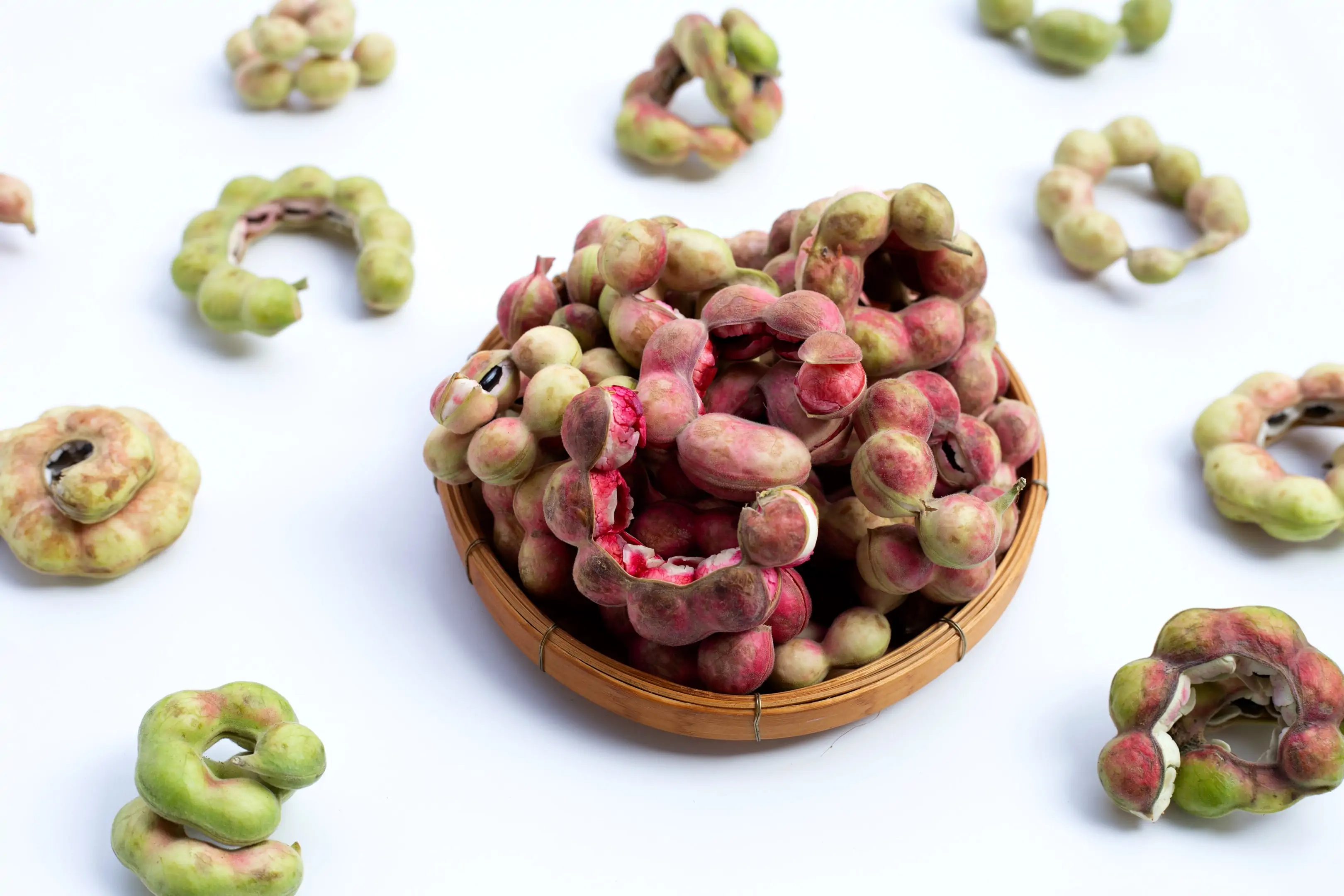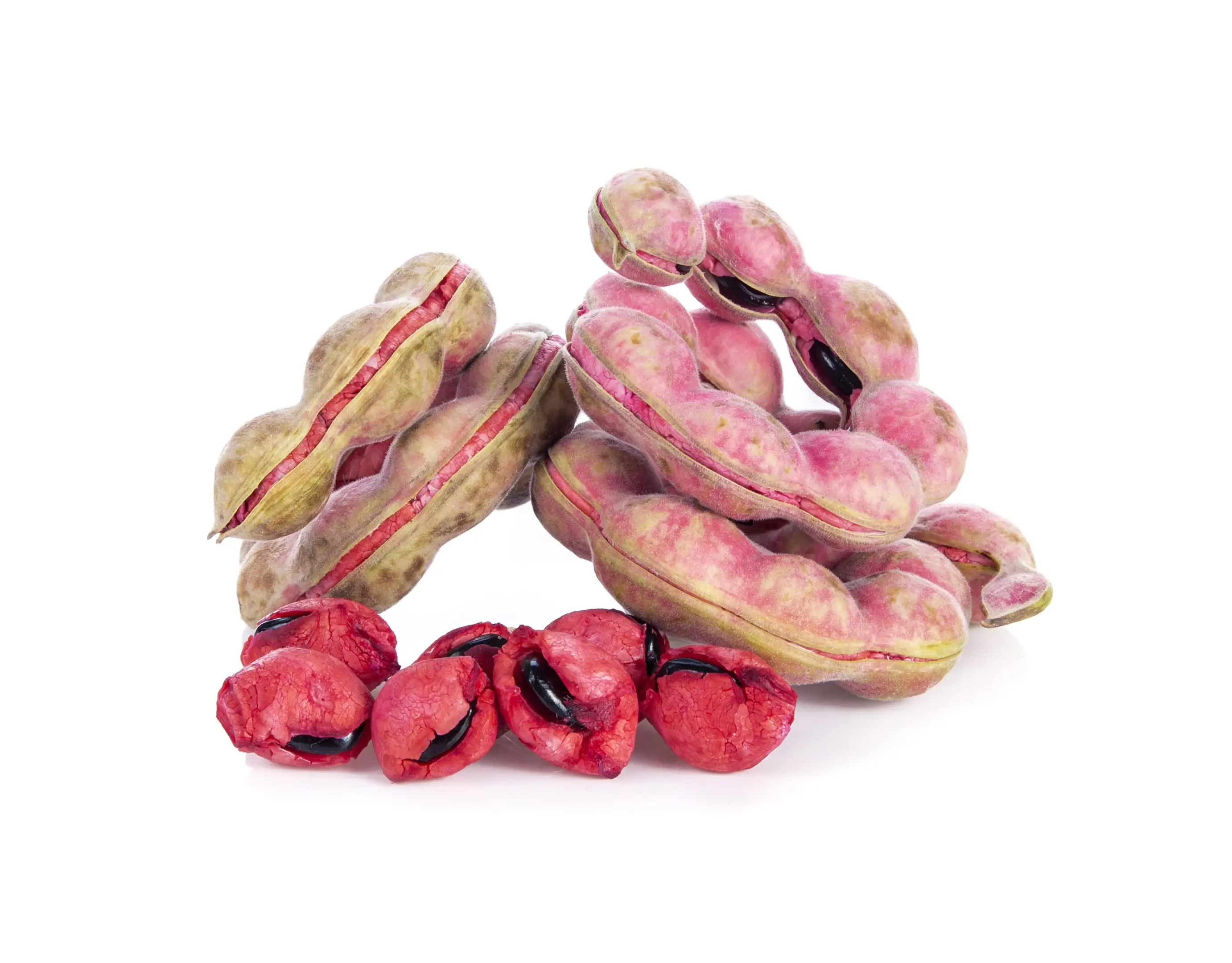Seeni puliyanga, or seema chintakaya, is a popular plant that grows all across the globe. It is credited with having numerous beauty and economic benefits. More importantly, it is also a great source of the necessary vitamins and nutrients.
In this article, you will learn more about this plant. The sections below will talk about the seeni puliyanga health benefits and how to add it to your diet.
Jump to:
What is seeni puliyanga?

This plant is native to the Pacific Coast and adjacent highlands of Mexico, Central America, and northern South America. It grows best in dry, tropical climates.
Typically, this plant is thorny. Its size ranges from small to medium-sized. The fruits of this plant are known for their uniquely sweet and sour flavor. It is considered a seasonal summer plant.
It is well-known for its distinctly shaped seed pods. The seed pods are usually spirally curved or perhaps coiled into one to two circles. The fruit itself is colored green or red, depending on its ripeness. Stale fruits turn brown over time.
Seeni puliyanga health benefits are another reason why it is popular. The plant's leaves, bark, and seeds all provide a host of nutritional benefits to whoever uses them.
Other names for the seeni puliyanga
In the scientific world, the seeni puliyanga goes by the name of Pithecellobium dulce. Scientists also call it by other junior synonyms such as Acacia obliquifolia, Inga camatchili, and many others.
You can find this plant all across the globe. With that, it also goes by different names. In English, it is called the Manila tamarind, Madras thorn, or Madras. Some people also call it the black pea, sweet Inga, or monkeypod.
If you go a little way to the south, you will discover that it goes by a different name in regions such as Mexico. There, it is called huamuche, guamuche, huamúchil, guamúchil, or cuamúchil.
This humble plant found its way to Asia through trading goods and riches with the Europeans. Notably, the Spaniards first introduced this wonder plant to Asia when they came to the Philippines through the Manila galleons. There, it is known as kamachile, kamunsil, kamantiris, or damorsil.
You can also find it in various parts of South Asia. In this region, the locals usually know it as plaeh umpel tek in Khmer, seema chintakaya in Telugu, bakhai ambli, or goras ambli in Gujarati, and singri in Hindi.
All of these names roughly translate to "foreign tamarind." This fact implies that it is not native to the area and was only introduced by traders, invaders, and the like.
What are the health benefits of seeni puliyanga?

This widely-spread plant is famous not just for its delicious and different flavor, but it is also well-known because of the health benefits it provides. The plant's seed pods are jam-packed with essential vitamins and nutrients, which means they are filled with health benefits.
The sections below will explain some seeni puliyanga health benefits, namely its nutritional content and the uses of its parts in medical settings.
1. Nutritional content
The seed pods of the Pithecellobium dulce are rich in carbohydrates and calories, which can provide energy. It is also rich in the essential vitamin, Vitamin C, which makes it an excellent immunity booster, especially now that we face a worldwide pandemic.
Additionally, the fruits' high fiber, protein, and water content help regulate one's digestive processes. It helps with appetite building and even weight loss!
If you are experiencing pain in areas such as your joints or muscles, then this plant may be able to help you. Seeni puliyanga is also rich in calcium and phosphorus, which help with bone strength.
This plant can also treat heart and circulation issues. Because the seed pods are also rich in iron, they can help produce more red blood cells and improve and smoothen blood circulation.
It is also rich in nutrients that help protect the liver from diseases, keeps diabetes at bay, and keeps the skin and hair looking fresh and healthy.
2. The leaves' health benefits
The leaves of the seeni puliyanga, otherwise known as seema chintakaya, have been used as an abortive in traditional medical settings. While this isn't highly advised, some people still use this when they are low on resources. However, alternative sources also state that the leaves help prevent miscarriages.
Traditional healers also use its leaves to help with digestive processes. It is mixed together with salt to cure indigestion. In regions like Nepal, the leaves of the seema chintakaya are also used to treat intestinal disorders.
Sometimes, the leaves are formed into a type of plaster to help relieve convulsions. There have been reports that this paste helps manage pain from venereal sores. It can also soothe painful and irritable inflammations.
When used with alcohol, the leaves of the Pithecellobium dulce help manage excess bile. In the long run, this can prevent issues with your liver and gallbladder.
Consuming a concoction made by boiling the leaves of this plant also helps treat leprosy. Gargling boiled leaves can also help alleviate toothaches. It also helps treat panophthalmitis, a condition whereby the coats of an eye become inflamed because of an infection.
3. The bark's health benefits
Traditional healers use the bark to treat a range of illnesses and ailments. These illnesses include but are not limited to diarrhea, dysentery, ulcers, and fever, among many others. There have also been reports that it helps with a skin condition called eczema, whereby the skin becomes itchy and irritated.
Typically, the bark is boiled in water for a few minutes and then consumed like tea. The amount of time you need to prepare the bark and how often you have to drink depends mainly on what you are trying to cure.
The most common method of preparing seeni puliyanga bark is by boiling it for ten to fifteen minutes. Then, you remove the bark by straining it. Once only the water is left, you can consume it hot or wait for the water to cool down.
4. The seeds' health benefits
The seed of the seeni puliyanga is often ground, juiced, eaten raw, or cooked to derive its many health benefits.
The first method of preparing the seeds is by pulverizing them. Traditionally, people use ground seeds to clean and treat ulcers. Healers will also have you ingest the seeds to treat internal ulcers. Aside from that, the seed's juice is also used to treat chest complications, such as chest congestion.
You can also save yourself the trouble of preparing them because they can be eaten raw. You will still get the same vitamins and nutrients. All you have to do is remove the skin and eat it!
Since the seeds of this plant are rich in essential nutrients, they are often incorporated into food such as curry. They are an excellent source of important nutrients like Vitamin C, B1, B2, and B6. These vitamins help boost immunity, elevate metabolism, and bolster memory, mood, and concentration.
It's also rich in thiamine, which helps convert sugar to energy. Added energy also means a spike in your overall mood. You will feel revitalized and more prepared for the challenges that every day poses.
What are the other benefits of the seeni puliyanga?

Aside from the health benefits it provides, the seeni puliyanga also has a host of other uses outside the medical field. It has uses in the beauty, environmental, energy, and manufacturing industries.
1. Beauty
Aside from keeping you healthy, the seeni puliyanga can also keep you looking beautiful. The plant is known for slowing down aging. In particular, it acts as a cure for difficult acne, lightens skin, and removes dark and stubborn spots. Perhaps this can be credited to the high levels of antioxidants and Vitamin E that are present in its seed pods.
If you are experiencing difficulties with your hair and scalp health, this plant will also prove very useful. Seeni puliyanga is also great for treating an oily and irritated scalp and preventing hair loss.
2. Environmental
Seeni puliyanga doesn't just improve people's health and life quality; it also does the same for the planet.
According to the United States Agriculture — Agricultural Research Service, this plant has been credited with improving soil quality. It can also be used in the agroforestry industry. Aside from this, it can also be used as an ornament, shade, or shelter.
3. Energy
Some innovative people have also found a way to use this plant to create fuel. It acts as fuel by making the wood into firewood. So not only does it power people, but it also has the potential to power homes, vehicles, and many more.
4. Manufacturing
Aside from being used as firewood, the bark of the plant can also be used for manufacturing processes.
The plant can also be used as a material for beads. These beads can eventually make their way into the market through hand-crafted jewelry.
How can you incorporate seeni puliyanga into your diet?

As mentioned before, the seeni puliyanga possesses an exciting flavor that might not appeal to all palates. However, those that do not enjoy this fruit are missing out. It can be eaten in a variety of ways, all of which are deceptively delicious. Not only that, but they are also packed with vital vitamins and nutrients to improve the consumer's overall health.
The seed pods can be eaten raw. This is done in various parts of the world, such as Mexico, the Philippines, Pakistan, and India. Eating it raw lets the consumer experience the flavor trip that is within the seeni puliyanga. The ripe ones are more sweet than sour, but there is no escaping the tarty taste of it.
The seeds are also used as a base for drinks with water and sugar in some parts of the world, such as in South America. In that region, this water, sugar, and seeni puliyanga mixture is called "agua de guamúchil." When translated, this phrase means guamúchil water.
In India, it is incorporated into popular dishes such as the famous Indian curry, chutney, and usili. For all three of these dishes, the unique flavor of the seeni puliyanga elevates and refines the overall taste of the dishes.
Adding this plant to your diet will do wonders for your body. You can be creative with it and experiment with the bold and fun flavor that it offers.
Think outside the box and make your own recipe. You can even add a cool and unique twist to an existing one. The possibilities for adding this plant to your diet are limitless!
Conclusion

The seeni puliyanga health benefits are innumerable. This wonder plant provides a host of benefits to whoever uses it. As evidence of this, it is a popular element of folk healing and medicine all across the globe. It is used to heal illnesses from South America to Southeast Asia and South Asia.
Seeni puliyanga's leaves, bark, and seeds have been credited to having medicinal and healing properties. They can be boiled with water, pulverized to a fine powder, made into a paste, or even eaten raw to derive their health benefits.
Adding this to your diet can be done in a few simple ways. You can either eat the fruits raw or add them to dishes like curry. In some parts of the world, the seeni puliyanga is even mixed with sugar and water to create a juice that people will consume.
All in all, this plant has something to offer for everyone. It's a great way to stay strong and healthy. It is very much needed now that we are still in a global pandemic.





Comments
No Comments